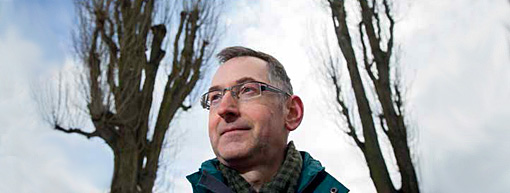In the middle of rural Staffordshire sit 30 hectares of wild, unmanaged oak woodland connected by a patchwork of farmers’ fields and hedgerows. Nothing out of the ordinary, you might think. But in fact this pocket of English countryside may yield extraordinary information that could transform global understanding of climate and environmental change on our trees and interdependent wildlife.
The woodland is the site of a unique scientific experiment – one of only two operating worldwide – called Free-Air Carbon dioxide Enrichment (FACE), which has been launched by the recently set up Birmingham Institute for Forest Research (BIFoR).
The ambitious, long-term project – ‘the ecological equivalent of the Large Hadron Collider (LHC)’– is aimed at discovering how UK woods and forests respond to the combined threats of climate change, invasive pests and diseases.
It will see an area of the forest being fed extra carbon dioxide (CO2) over the course of at least a decade in order to measure its effect on plant growth. This will allow better estimation of how the growth of trees will alter in the future as CO2 levels rise in the atmosphere.
BIFoR Director Rob MacKenzie, Professor of Atmospheric Science at the School of Geography, Earth and Environmental Sciences, explains: ‘What we’re doing is following the carbon – seeing if the extra CO2 gets locked away in the soil, or results in trees growing more leaves or bigger trunks. Will invertebrates enjoy the extra sugar and will the carbon in fact work through the ecosystem and back into the atmosphere?’

Although FACE experiments have been conducted a handful of times before, previous trials have mainly been done on young trees in plantations – never on unmanaged forests of mature trees, which make up most of the world’s woodland.
‘This is something we have wanted to do for decades, but funding councils weren’t brave enough to support it, because it’s an experiment that takes £10 million to make happen and at least ten years to run due to the fact you can’t easily accelerate living systems,’ says Rob. ‘It’s very large-scale in scope, although there will be outputs quite quickly: Already we’ve started to characterise the piece of woodland, so we’re getting observable science right from the get-go.’
BIFoR was made possible by a £15million donation – thought to be one of the biggest made to a UK university – from alumnus and retired Professor of Immunology Jo Bradwell. He also donated the woodland, situated between Stafford and Telford, because he felt research into forest health was lagging behind the big advances that had been made in human health research.
Separate aspects of the forest ecosystem, such as leaf growth, have been studied extensively, ‘but we’ve known for decades that the classic reductionist approach doesn’t work. It helps, but it doesn’t solve the whole problem. Sooner or later you have to look at the problem in all its complexity.’
That complexity involves trees of varying ages, as the hypothesis is that environmental changes affect young and old plants differently.
‘Carbon dioxide is the food of a plant – along with sunlight and water, CO2 makes sugar and it uses that for everything else – and there’s an analogy with people,’ says Rob. ‘We know that if you give sugar to young children, they will run around, fall over, scream, shout, and grow, but if you give it to adults, it will put their metabolism out of kilter and they will put on weight. We expect something similar to be true of the forest system. In the trade it’s known as “carbon allocation”. The tree is making the building blocks of the plant. It can respond to changes in environmental conditions by putting that carbon in different places – growing more roots, more branches or more of a trunk.
‘One thing we think is particularly interesting is the kind of trade that goes on between trees and micro-organisms that live in, on and around the trees, especially with fungi. There’s a kind of swapping: trees have the carbon and fungi have the nitrogen that the trees need to make proteins and other building blocks. So the trees will swap carbon for nitrogen. This is a way of living together called symbiosis. Exactly how important it is in the global carbon cycle is becoming more and more apparent.’
The FACE experiment involves setting up six rings of pipes – each 30 metres in diameter and as high as the trees –in an area of the forest. The pipes are peppered with tiny holes through which air containing extra CO2 is pumped, bathing all the plants inside the ring but not elsewhere in the woodland.
‘The FACE rings have to be unobtrusive, because you’re trying to change nothing else apart from the CO2 level: so wind, seeds and insects can come and go freely,’ says Rob. ‘That’s why you can’t do this experiment in a lab: you would inadvertently change more than just the level of carbon.’
BIFoR, which is also putting a renewed focus within the University on plant pathology and physiology, aims to become a world-leading research centre, bringing together a wide range of expertise from across the University, from bioscientists and ecologists to economists and sport and literature researchers.
‘One of my key roles is to make sure BIFoR acts as an enabler of research right across campus, so that we get a plethora of important results,’ says Rob.
Other aspects of forest health – including disease systematics and diagnostics and tree defence – are also being studied. It is, however, the FACE experiment that is causing the most excitement in scientific circles – and has the potential for producing results crucial to our understanding of the effects of atmospheric changes.
‘This is the climate change experiment we’ve been dreaming of – and we’re confident we can make it work.’